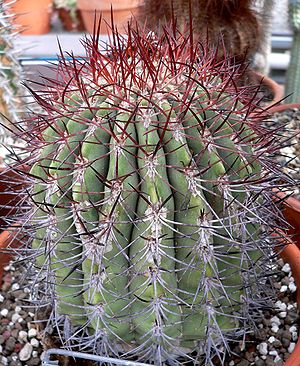Denmoza rhodacantha
| Denmoza rhodacantha | ||||||||||||
|---|---|---|---|---|---|---|---|---|---|---|---|---|

Denmoza rhodacantha |
||||||||||||
| Systematics | ||||||||||||
|
||||||||||||
| Scientific name of the genus | ||||||||||||
| Denmoza | ||||||||||||
| Britton & Rose | ||||||||||||
| Scientific name of the species | ||||||||||||
| Denmoza rhodacantha | ||||||||||||
| ( Salm-Dyck ) Britton & Rose |
Denmoza rhodacantha is the only plant species of the monotypic genus Denmoza in the cactus family(Cactaceae). The botanical name of the genus is an anagram of the name of the Argentine province of Mendoza , where the species was found.
description
Denmoza rhodacantha grows individually and has spherical to short cylindrical shoots that reach a height of up to 1.5 meters with a diameter of 20 to 30 centimeters. The no less than 30 ribs are up to 1 centimeter high and wide at the base. The areoles , which were initially separated , later merge and produce brownish-red, then graying thorns , which are very different on young and old plants. The central spine, which can also be missing, becomes 2 to 3 centimeters long. The 8 to 10 awl radial spines are slightly curved. The areoles from which the flowers arise bring out several long, brown bristles as well as thorns up to 7 centimeters long.
The tubular, disymmetrical flowers that arise near the tip of the shoots and open during the day are scarlet red. The usually curved corolla tube is slightly widened over the pericarpellet, which is covered with small, pressed scales . On red stamens seated dust bag and pen project at least 10 mm out of the tube. The nectar chamber is closed by a wreath of staminodes that have receded into hair .
The spherical fruits , covered with hair-like clusters of thorns, are dry when ripe and tear open sideways from above. They contain shiny blackish brown seeds about 1.3 millimeters in diameter.
Denmoza rhodacantha is pollinated by hummingbirds .
Distribution, systematics and endangerment
Denmoza rhodacantha is widespread in the northwest and west of Argentina on the eastern slopes and foothills of the Andes in the provinces from Mendoza to Salta at altitudes of 800 to 2800 meters.
The first plants were probably discovered in 1821 by John Gilles near the city of Mendoza . They were given the name Cactus coccinea , but it was never validly described. The first description of the species as Echinocactus rhodacanthus was made in 1834 by Joseph zu Salm-Dyck Reifferscheidt . Nathaniel Lord Britton and Joseph Nelson Rose established the genus Denmoza for the species in 1922 .
The International Cactus Systematics Group of the International Organization for Succulent Research had initially placed Denmoza rhodacantha in the genus Cleistocactus in 1986 , before recognizing this as an independent genus in 1999.
Recombinations into the genera Cereus , Cleistocactus , Echinopsis , Oreocereus and Pilocereus resulted in numerous synonyms for the species. Demnosa Frič is a synonym for the genus .
In the Red List of Threatened Species of the IUCN , the species is listed as " Least Concern (LC) ". H. listed as not endangered.
proof
literature
- Edward F. Anderson : The Great Cactus Lexicon . Eugen Ulmer KG, Stuttgart 2005, ISBN 3-8001-4573-1 , p. 177-178 .
- Curt Backeberg : Die Cactaceae: Handbuch der Kakteenkunde . 2nd Edition. tape II . Gustav Fischer Verlag, Stuttgart New York 1983, ISBN 3-437-30381-3 , p. 1043-1048 .
- NL Britton , JN Rose : The Cactaceae . Descriptions and Illustrations of Plants of the Cactus Family . tape III . The Carnegie Institution of Washington, Washington 1922, p. 78-79 ( online ).
Individual evidence
- ↑ Hortus Dyckensis or catalog des plantes cultivées dans les jardins de Dyck . P. 341.Dusseldorf, Arnz 1834
- ↑ David Hunt: CITES Cactaceae Checklist . 2nd edition, Royal Botanic Gardens, London, 1999. ISBN 1-900347-45-8
- ↑ Denmoza rhodacantha in the IUCN Red List of Threatened Species 2013.2. Posted by: Méndez, E. & Ortega-Baes, P., 2010. Retrieved February 16, 2014.